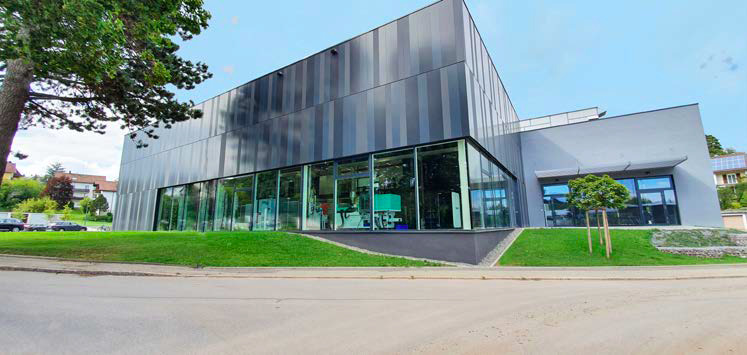In the “H2FastCell” research project, a research team from Fraunhofer IPA and the Black Forest Campus is working with an industrial consortium to develop a robotic cell for the automated high-speed assembly of fuel cell stacks. In doing so, they are laying the foundation for industrial mass production of this emission-free technology. Hydrogen will play an important role as an energy carrier. It can be produced from renewable energies in electrolysers in a CO2-neutral way and then converted into electrical energy in fuel cells. Particularly in freight transport, fuel cells can play out their advantages over battery-electric vehicles. But there are also many future areas of application for fuel cells in the stationary sector. In the production of fuel cells, efficient cycle times and absolute precision are crucial.
The major goal is to reduce manufacturing costs in order to make the use of this technology more economical. However, this can only be achieved through scaling effects, which require fully automated plants with correspondingly high capacities. At the moment, this type of production plant is not yet available on the market, and the design of the components must also continue to be optimized with regard to automation-compatible construction.
That’s why it makes sense to start looking now for ways to manufacture them in an automated way that is suitable for mass production. This is precisely what a research team from the Fraunhofer Institute for Manufacturing Engineering and Automation IPA and the Center for Digitalization, Leadership and Sustainability Black Forest (Black Forest Campus) has set out to do in the “H2FastCell” project. Together with teams from five companies, the scientists want to develop a robotic cell by 2023 that assembles the individual layers of a fuel cell in seconds and with absolute precision.
13 minutes to the finished stack
A fuel cell stack consists of stacked layers of bipolar plates, through which hydrogen and oxygen are introduced, and membrane electrode units, in which the two chemical elements react with each other. Because this reaction only produces a voltage of one volt at most, about 400 fuel cells must be stacked on top of each other for a fuel cell engine to power a truck, for example. Precision is required here. Any deviation — even in the micrometer range — can reduce the performance of the fuel cell system.
The assembly robot, which will take over the stacking of bipolar plates and membrane electrode units in alternation in the H2FastCell research project, will therefore scan the individual layers as it grips them. Since he stacks several stacks in parallel, he can spontaneously assign a layer to the stack on which the dimensions fit best. Performance degradations are thus avoided before they occur. All this is supposed to happen so fast that it will be difficult for humans to follow the individual assembly steps with the naked eye: one second per layer. A stack composed of 400 individual fuel cells would therefore be finished after only about 13 minutes. Manually, many times that time would be needed.
Prices for fuel cells could fall
“If the throughput of the stacks is increased in this way, it will lay the foundation for the industrial mass production of fuel cells. Prices would fall and the use of fuel cells in mobile heavy-duty applications would finally become competitive,” says Friedrich-Wilhelm Speckmann of the Center for Digitized Battery Cell Production at Fraunhofer IPA. He and Erwin Groß from the Corporate Strategy and Development department at Fraunhofer IPA are leading the H2FastCell research project.
Demonstrator stacking facility at the Black Forest Campus.
By summer 2023, the research team aims to have set up a demonstrator stacking facility for automated fuel cell assembly at the Schwarzwald Campus in Freudenstadt. This facility will be available to companies for further trials, feasibility studies and validations.
“With this first project, we are laying the foundation for our future research center for biointelligent hydrogen cycle management in the Black Forest. With this, we want to make hydrogen technology usable for mobile and stationary use as an energy carrier together with companies in Baden-Württemberg.”
- Stefan Bogenrieder, Managing Director of the Black Forest Campus
The H2FastCell research project started on July 26, 2021 and is scheduled to run for two years. In addition to Fraunhofer IPA and the Black Forest Campus, five companies from Baden-Württemberg are involved: the software developer ISG Industrielle Steuerungstechnik GmbH from Stuttgart, the vacuum technology manufacturer J. Schmalz GmbH from Glatten in the northern Black Forest, the sensor producer i‑mation GmbH from Rottweil, the machine and plant manufacturer teamtechnik Maschinen und Anlagen GmbH from Freiberg am Neckar, and the automation engineer WEISS GmbH from Buchen in the Odenwald. The Baden-Württemberg Ministry of Economics, Labor and Tourism is funding H2FastCell with around 2.3 million euros.

















